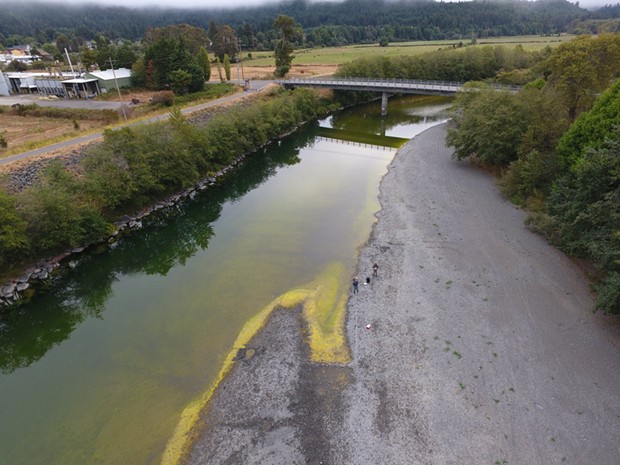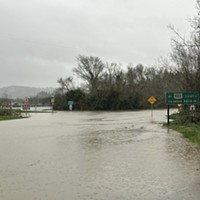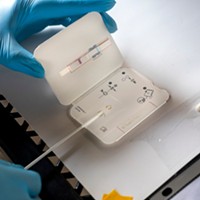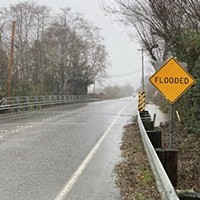Tuesday, September 15, 2020
Blue-Green Algae Found in Mad River
Posted By Kimberly Wear @kimberly_wear on Tue, Sep 15, 2020 at 7:57 PM
Public Health and Environmental Health officials are cautioning residents to stay out of the water after cyanobacteria — also known as blue-green alage — was confirmed at three locations on the Mad River.
According to a news release, the samples were collected at the Mad River Recreational location commonly known as Sewer Ponds, at Pump Station 4 and downstream of the Hatchery Road bridge.
“Most cyanobacteria do not affect animals or people, however, a small number of cyanobacteria species are capable of producing toxins that can be harmful to animals and humans,” the release states. “Dogs and children are most likely to be affected because of their smaller body size and tendency to stay in the water for longer periods of time."
Read the full release below:
According to a news release, the samples were collected at the Mad River Recreational location commonly known as Sewer Ponds, at Pump Station 4 and downstream of the Hatchery Road bridge.
“Most cyanobacteria do not affect animals or people, however, a small number of cyanobacteria species are capable of producing toxins that can be harmful to animals and humans,” the release states. “Dogs and children are most likely to be affected because of their smaller body size and tendency to stay in the water for longer periods of time."
Read the full release below:
Samples with confirmed cyanobacteria were collected at three locations on the Mad River spurring local Public and Environmental Health Officials to warn community residents to keep themselves and their pets out of the water.
The samples containing the cyanobacteria, also known as blue-green algae, were collected by an Environmental Scientist for the Blue Lake Rancheria at the Mad River Recreational location known as Sewer Ponds, at Pump Station 4 and downstream of the Hatchery Road bridge.
Most cyanobacteria do not affect animals or people, however, a small number of cyanobacteria species are capable of producing toxins that can be harmful to animals and humans. Dogs and children are most likely to be affected because of their smaller body size and tendency to stay in the water for longer periods of time.
Cyanobacteria can be present in any freshwater body. It looks like dark green, blue-green, black, orange or brown scum, foam or mats on the riverbed or floating on the water. Warm water and abundant nutrients can cause cyanobacteria to grow more rapidly than usual causing “blooms.”
These blooms are termed “harmful algal blooms.”
Officials recommend the following guidelines for recreational users of freshwater areas: Keep children, pets and livestock from swimming in or drinking water containing algal scums or mats.
Adults should also avoid wading and swimming in water containing algal blooms.
Try not to swallow or inhale water spray in an algal bloom area.
If no algal scums or mats are visible, you should still carefully watch young children and warn them not to swallow any water.
Fish should be consumed only after removing the guts and liver and rinsing fillets in tap water.
Never drink, cook with or wash dishes with water from rivers, streams or lakes.
Get medical attention immediately if you think that you, your pet, or livestock might have been poisoned by cyanobacteria toxins.
Be sure to tell the doctor or veterinarian about possible contact with cyanobacteria or algal blooms.
Join or support one of the many watershed and river organizations.
In previous years, cyanobacteria was confirmed in some water bodies within Humboldt and surrounding counties, including the Mad River, South Fork Eel River, Van Duzen River, Trinity River, Clear Lake and Lake Pillsbury.
It is difficult to test and monitor the many lakes and miles of our local rivers. Most blooms in California contain harmless green algae, but it is important to stay safe and avoid contact.
To learn more about cyanobacteria and harmful algal blooms, visit the state of California’s website at www.mywaterquality.ca.gov/habs/index.html.
To learn more about cyanobacteria and algae on the South Fork Eel River, visit www.eelriverrecovery.org/algae.html.
To report a bloom, e-mail [email protected] or call 844-729-6466 (toll free). Blooms can also be reported via the “bloomWatch” app which is available for free download on iTunes or Google play.
For information on conditions occurring within Humboldt County, contact the Division of Environmental Health at 707-445-6215 or 800-963-9241. Photos of suspected blooms can also be emailed to [email protected].
Speaking of...
Readers also liked…
more from the author
-
Dust to Dust
The green burial movement looks to set down roots in Humboldt County
- Apr 11, 2024
-
Our Last Best Chance
- Apr 11, 2024
-
Judge Rules Arcata Can't Put Earth Flag on Top
- Apr 5, 2024
- More »



































